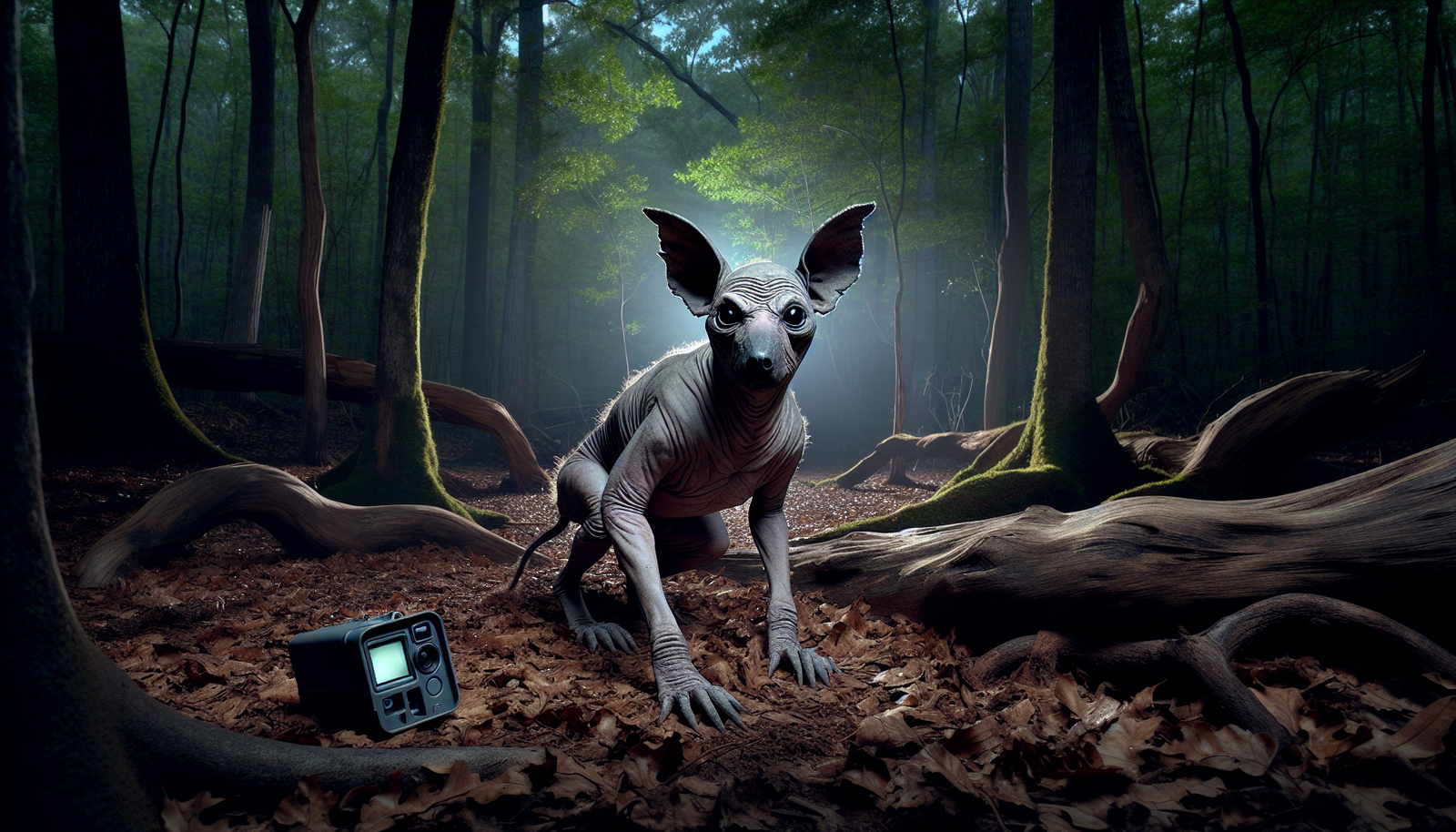Chupacabra Sightings Stir Up Cryptid Craze in Alabama

By Wade Beaumont, Cryptozoologist
Howdy, folks! Wade Beaumont here, and I've got a doozy of a tale for y'all. Picture this: you're out in the Alabama woods, minding your own business, when suddenly your trail cam captures a downright spooky image. A creature, hairless and gaunt, staring right into the lens with soulless eyes. Your first thought? Chupacabra.
Now, I know what you might be thinking. Chupacabra? In Alabama? Ain't that a bit far from its usual stomping grounds down in Latin America? Well, let me tell you, the legend of this blood-sucking cryptid has spread far and wide, and it seems to have taken a particular liking to the Heart of Dixie.
But before we dive into the recent sightings that have gotten Alabamians all riled up, let's take a step back and look at where this whole chupacabra business started.
The Chupacabra Legend
The word "chupacabra" comes from the Spanish words "chupar," meaning to suck, and "cabra," meaning goat. Put 'em together and you've got yourself a "goat sucker." Now, this ain't no ordinary livestock thief we're talking about. No sir, the chupacabra is said to be a downright terrifying beast, with a taste for blood that'd make a vampire bat blush.
The legend of the chupacabra first reared its ugly head back in 1995 in Puerto Rico. Folks started reporting strange attacks on their animals, with the poor critters turning up dead, drained of blood, and with peculiar puncture wounds. Eyewitnesses described a creature that was unlike anything they'd ever seen before. Some said it had a reptilian body, all covered in spikes. Others claimed it had glowing red eyes and razor-sharp fangs.
As word of this mysterious predator spread, so did the fear. Soon, reports of chupacabra attacks were popping up all over Latin America, from Mexico to Brazil. And it wasn't long before the legend made its way north, to the southern United States.
Now, over the years, the description of the chupacabra has changed a bit. While early reports painted a picture of a spiny, lizard-like monster, more recent sightings describe something that looks more like a hairless, mange-ridden dog or coyote. But no matter what form it takes, one thing remains the same: the chupacabra's reputation as a fearsome, blood-sucking beast.
Alleged Chupacabra Sightings in Alabama
Fast forward to February 2023, and the chupacabra craze hits a little closer to home. The Alabama Wildlife and Freshwater Fisheries Division (AWFFD) posts some mighty peculiar photos on their social media, straight from one of their trail cams. The images show a strange, hairless canine, all skinny and sickly looking. It's a far cry from the majestic creatures we usually associate with the great outdoors.
Well, folks on the internet took one look at those photos and the speculation started flying. "That's no ordinary coyote," they said. "That's a genuine, bonafide chupacabra!" The photos spread like wildfire, with folks from all over the state chiming in with their theories and stories.
Now, the wildlife experts at AWFFD, they had a different take on the situation. They came out with a statement saying that the creature in the photos was most likely just a coyote with a severe case of mange. You see, mange is this nasty skin disease caused by mites, and it can make an animal lose all its fur and look downright ghastly. It's a sad sight, but it ain't nothing supernatural.
But here's the thing: this ain't the first time Alabamians have cried chupacabra. The AWFFD says they get reports of supposed chupacabra sightings pretty regularly, from all over the state. Tuscaloosa, Lee, Talladega - seems like every county has its own version of the story.
Explanations for Chupacabra Sightings
Now, if you ask a biologist about the chupacabra, they'll likely give you a polite smile and a shake of the head. To them, the chupacabra is nothing more than a myth, a spooky story to tell around the campfire. They'll tell you that every alleged sighting can be explained by a case of mistaken identity. A mangy coyote, a hairless raccoon, maybe even a poor dog that's seen better days.
But the cryptozoologists, they ain't so quick to dismiss the legend. Some of them think the chupacabra could be a whole new species, something science ain't discovered yet. Others reckon it could be some sort of escaped lab experiment, a creature cooked up in a secret government facility somewhere.
Personally, I think the truth probably lies somewhere in between. While I ain't one to believe in monsters, I do think there's something powerful about the unknown, about the mysteries that lurk in the shadows of our world. And whether the chupacabra is real or not, there's no denying that it's captured the imaginations of folks all over.
I reckon it's human nature to be drawn to the extraordinary, to want to believe in something beyond the everyday. And in a world that can feel mighty mundane at times, a little bit of chupacabra craziness might just be the spice of life we all need.
The Chupacabra's Impact on Alabama Culture
Speaking of spice, have y'all heard about the Chupacabra 10K and Half Marathon? Yep, you read that right. Down in Huntsville, they've got a whole dang race named after the legendary goat sucker.
It's part of the "Wild Thangs" Trail Series, and let me tell you, the terrain is about as wild as the name suggests. Runners gotta navigate some serious hills and hollers, all while keeping an eye out for any hairless, blood-sucking critters that might be lurking in the woods.
But the race ain't the only way the chupacabra has left its mark on Alabama culture. Seems like every time there's a new sighting or a strange photo, folks can't help but start speculating. It's the talk of the town, from the local diner to the church pews.
And let's be real, it's added a whole new level of excitement (and maybe a touch of paranoia) to hiking and camping in the state. Suddenly, every rustle in the bushes could be a chupacabra, every strange howl in the night a sign of an impending attack.
But hey, if you do spot something that looks like it might be our hairless friend, the AWFFD wants to know about it. They encourage folks to send in their photos and reports, so they can keep tabs on any potential mange outbreaks in the local wildlife population.
Final Thoughts
So there you have it, folks. The chupacabra, the legendary blood-sucking cryptid from Latin America, has found a new home in the hearts and minds of Alabamians. Whether it's real or not, there's no denying the impact it's had on the state's culture and imagination.
Now, I ain't saying you should go out and start hunting for chupacabras. And I certainly ain't saying you should believe every tall tale and blurry photo that crosses your path. But I do think there's something to be said for embracing the unknown, for allowing ourselves to be thrilled by the possibilities that lie just beyond the edge of our understanding.
So the next time you're out in the Alabama woods and you hear a strange rustling in the underbrush, don't be too quick to dismiss it as just another critter. Take a moment to wonder, to imagine. And who knows? Maybe, just maybe, you'll catch a glimpse of something extraordinary.
Until next time, y'all. Keep your eyes open and your cameras ready. The truth is out there, and it might just be hairless and blood-thirsty.
From Bigfoot to UFOs: Hangar 1 Publishing Has You Covered!
Explore Untold Stories: Venture into the world of UFOs, cryptids, Bigfoot, and beyond. Every story is a journey into the extraordinary.
Immersive Book Technology: Experience real videos, sights, and sounds within our books. Its not just reading; its an adventure.



























